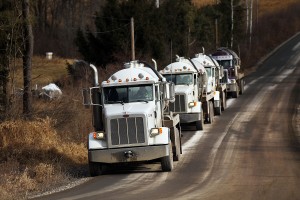DEP Says Marcellus Air Emissions Data Show Small Footprint
-
Susan Phillips
The Pennsylvania Department of Environmental Protection Secretary Michael Krancer says air emissions associated with Marcellus Shale production are a “small fraction of air pollution in the state.” The DEP announced the release of air emissions data collected in 2011. In the announcement, Secretary Krancer stressed that air emissions in the state have dropped since drilling began in earnest back in 2008.
“It is worth noting that annual sulfur dioxide emissions are down more than half a million tons per year from where they were in 2008,” Krancer said in a press release. “This is a direct result of air quality regulations and the increased use of natural gas in the power generation sector.”
“While statewide emissions from the extraction industry are relatively small compared to some other major sources of air pollution in the state (e.g., SO2 from GW-scale coal-fired power plants), these emissions sources are nevertheless a concern in regions of significant extraction activities. More detailed analyses, including regional data acquisition and consideration of site-specific variability, will be valuable in regions of intense extraction activity and for specific activities and pollutants shown in this analysis to be of most potential concern. And while significant uncertainty may exist for some potential risks of shale gas extraction, under current standard practices, shale gas extraction will be associated with non-trivial air pollution emissions.”
 The Rand Corporation study looked at four sources of regional air pollutants resulting from natural gas production. These include truck traffic, emissions from the well sites during drilling and hydraulic fracturing, the use of diesel engines, fugitive emissions from the wellhead, and emissions associated with the transport of gas via compressor stations.
The Rand Corporation study looked at four sources of regional air pollutants resulting from natural gas production. These include truck traffic, emissions from the well sites during drilling and hydraulic fracturing, the use of diesel engines, fugitive emissions from the wellhead, and emissions associated with the transport of gas via compressor stations.

















